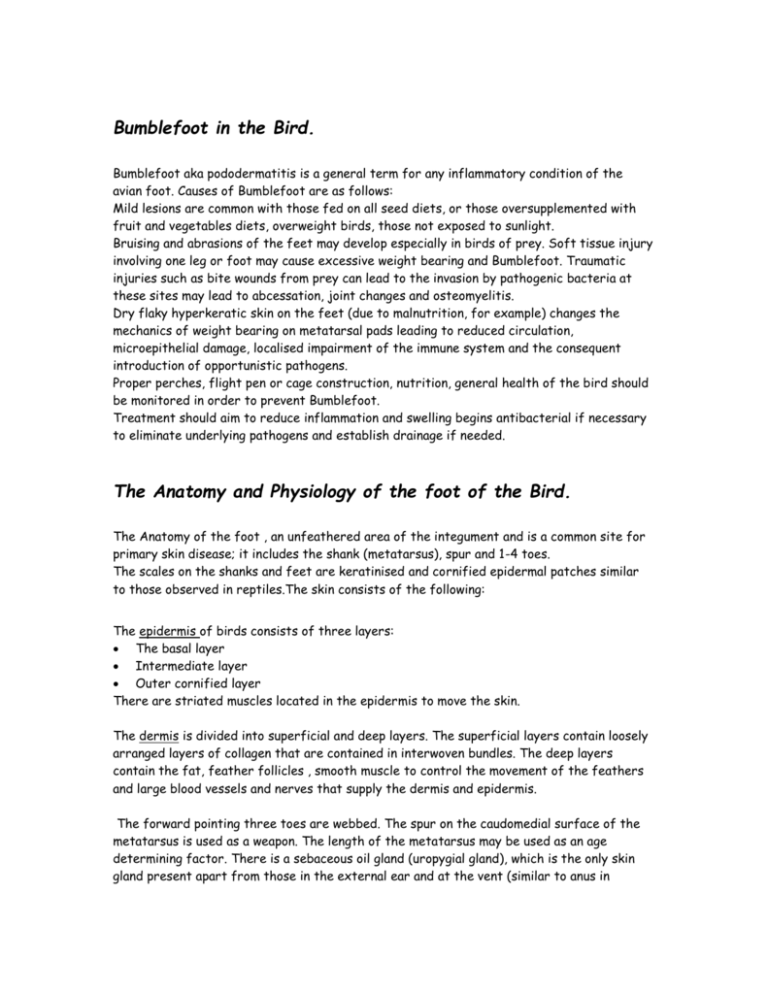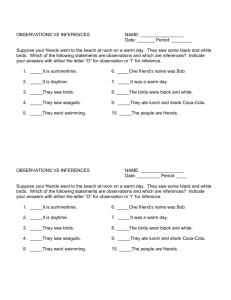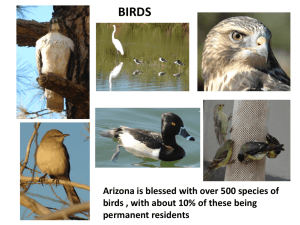Bumblefoot in the Bird - D-mis
advertisement

Bumblefoot in the Bird. Bumblefoot aka pododermatitis is a general term for any inflammatory condition of the avian foot. Causes of Bumblefoot are as follows: Mild lesions are common with those fed on all seed diets, or those oversupplemented with fruit and vegetables diets, overweight birds, those not exposed to sunlight. Bruising and abrasions of the feet may develop especially in birds of prey. Soft tissue injury involving one leg or foot may cause excessive weight bearing and Bumblefoot. Traumatic injuries such as bite wounds from prey can lead to the invasion by pathogenic bacteria at these sites may lead to abcessation, joint changes and osteomyelitis. Dry flaky hyperkeratic skin on the feet (due to malnutrition, for example) changes the mechanics of weight bearing on metatarsal pads leading to reduced circulation, microepithelial damage, localised impairment of the immune system and the consequent introduction of opportunistic pathogens. Proper perches, flight pen or cage construction, nutrition, general health of the bird should be monitored in order to prevent Bumblefoot. Treatment should aim to reduce inflammation and swelling begins antibacterial if necessary to eliminate underlying pathogens and establish drainage if needed. The Anatomy and Physiology of the foot of the Bird. The Anatomy of the foot , an unfeathered area of the integument and is a common site for primary skin disease; it includes the shank (metatarsus), spur and 1-4 toes. The scales on the shanks and feet are keratinised and cornified epidermal patches similar to those observed in reptiles.The skin consists of the following: The epidermis of birds consists of three layers: The basal layer Intermediate layer Outer cornified layer There are striated muscles located in the epidermis to move the skin. The dermis is divided into superficial and deep layers. The superficial layers contain loosely arranged layers of collagen that are contained in interwoven bundles. The deep layers contain the fat, feather follicles , smooth muscle to control the movement of the feathers and large blood vessels and nerves that supply the dermis and epidermis. The forward pointing three toes are webbed. The spur on the caudomedial surface of the metatarsus is used as a weapon. The length of the metatarsus may be used as an age determining factor. There is a sebaceous oil gland (uropygial gland), which is the only skin gland present apart from those in the external ear and at the vent (similar to anus in mammals). The secretion of this gland is carried to the body and wing feathers during preening. The uropygial gland is prominent in some species and has a water proofing function. The Common Clinical Procedures: Blood sample collection: In birds the circulating blood volume is generally between 6 and 12 ml /100g body weight( 10% of the body weight). Overall birds can tolerate a greater degree of blood loss in relation to size than can mammals. The suitable locations for blood collection are the right-sided jugular vein, which unlike mammals, is more mobile and can be found subcutaneously over the right side of the neck. This site cannot be used in pigeons, as there is an extensive. Place finger under the neck with the birds head extended, the skin can be tensed over the site and the thumb can be placed in the thoracic inlet to raise the vein. Urine sample collections: urea forms 20-40%of avian nitrogenous waste and is excreted by glomerular filtration.In normally hydrated birds a little urea is reabsorbed, whereas in dehydrated birds, nearly all urea is reabsorbed into the bloodstream. Therefore any factor such as cardiopathy or dehydration can cause a rapid rise of urea in the plasma. Common Injection sites: The most common injection site for birds of parenteral administration of drugs is in the intramuscular region. Either the pectoralis or the iliotibialis lateralis or biceps femoris muscle can be used. Injections can be given subcutaneously but only one or two sites are suitable because the avian skin is inelastic and fluids tend to leak out at point of needle puncture. Injections can be given intravenously and is most easily given to the brachial vein but can also be given to the tarsal vein on the medial surface of the leg, as can the right jugular vein.







